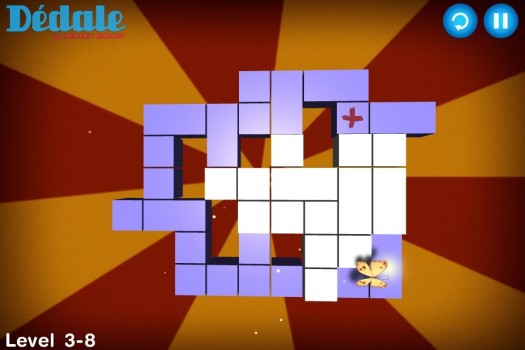![]() Sergey Mohov’s Dédale ($0.99) is a game of wide open mazes set down with brilliant white tiles. You flit from tile to tile as a colorful butterfly, leaving your own trail of color behind you. It is, in a word, tranquil. It’s also occasionally hair-tearingly frustrating, but only when you just can’t win.
Sergey Mohov’s Dédale ($0.99) is a game of wide open mazes set down with brilliant white tiles. You flit from tile to tile as a colorful butterfly, leaving your own trail of color behind you. It is, in a word, tranquil. It’s also occasionally hair-tearingly frustrating, but only when you just can’t win.
You may have played games like this before; Dédale relies on that foreknowledge. It doesn’t fuss with in-depth tutorials. You have a blank canvas of white tiles in front of you. Once you decide where to touch down, each tile you pass over changes colors. You have the context for this. You know what to do.
Is maze the best word for these puzzles? They have no beginning but the one you choose, no end but the moment you’ve painted every tile. The only walls are the gaps in the levels design, and the ones you create yourself with the colored tiles that trail behind your little butterfly. But don’t be fooled: that starting point, that ending point, those walls are all there. You just can’t see them until you find the right path. Choose poorly and you’re left with trailing, unpainted pathways, inaccessible islands of abandoned white tiles, and the bitter taste of failure.
Each level is accompanied by gentle, ambient backing tracks by Fractures. Each move you make plinks out a piano note. Between these things, the butterfly, and the pretty colors, Dédale is downright meditative at times.
I could see this game as great stress-relief— at least, right up until the moment you can’t find a solution. Thankfully, Mohov has left emergency exits in case of frustration. There is a carefully limited level skip that only seems to work if you haven’t made a move. Odd choice, that. More helpfully, you can hit a button at any point to show you the recommended starting tile. It spoils a bit of the fun, but it can also be a lifesaver. Use it wisely. If only there was an undo button there would be nothing standing between this game and inner peace.
You probably won’t have cause to get frustrated early on. It isn’t terribly challenging to complete a standard level, no matter how twisted its corridors become. Then special tiles start getting scattered throughout, and things get more difficult. Clear tiles must be passed over twice, once to solidify them and a second time to paint them. Not only does this multiply the possible paths, it makes it that much harder to tell where to begin. Then there are the arrow-imprinted tiles. You can feel free to ignore them, or you can flip them and use them. Deciding which approach to take turns Dédale into much more of a puzzle.
There are 100 handcrafted levels to paint your way through, hours of content that ranges from mindless to mind-bending. Some of those are wasted on the terribly simple levels that introduce each new world, but there is always leads to a good challenge by the end. Others are a special treat, with layouts that resemble certain old friends. For a chance of pace, you can also futz around with the Dédale-O-Matic, which procedurally generates basic levels. A gimmick, yes, though it’s a laugh to see how awkward these non-curated levels can be. For more legitimate longevity, the developer tells us that Game Center support is on its way in the next update.
There is a backdrop of familiarity to everything Dédale does, but it does a great job with mechanics most of us know by heart. The puzzles offer a good challenge without becoming painful, and the special tiles add some clever twists. And on the way to teasing your brain, Dédale takes you away from your troubles. Who couldn’t use a few moments of calm?
